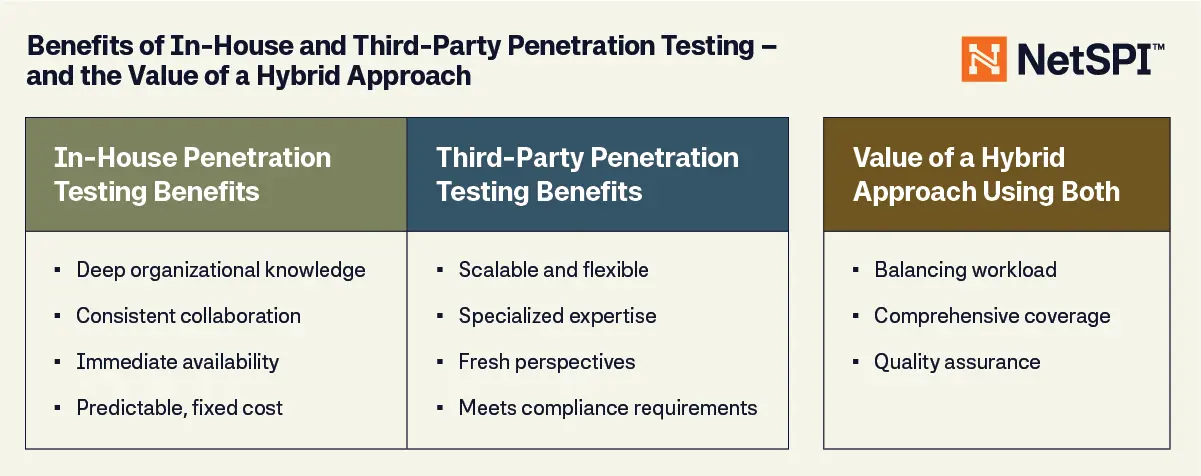
The Balancing Act of In-House vs Third-Party Penetration Testing
TL;DR
Balancing in-house and third-party penetration testing involves weighing control and customization against scalability and specialized skills. In-house teams offer deep organizational knowledge and build a culture of security internally, but they can be costly. Outsourcing pentesting to a third-party provides access to expert talent, flexibility, and cost-effectiveness, but may pose quality and dependency risks. Effective pentesting programs often combine both approaches to optimize resources and manage fluctuating demands. Selecting the right provider depends on their quality, engagement process, flexibility, and additional advantages.
Introduction
Penetration testing is a critical practice for any organization serious about cybersecurity. But I’ve seen the debate between insourcing and outsourcing these crucial efforts go on for years. While many security teams have talented in-house pentesting specialists, I’ve found that the most effective approach often involves both in-house expertise and third-party penetration testers.
This hybrid model offers the flexibility and scalability necessary to create a robust and dynamic penetration testing program. Here’s why I believe that integrating both in-house and third-party penetration testing can produce superior results.

The Value of In-House Penetration Testing
Deep Organizational Knowledge
In-house penetration testers have the advantage of being deeply embedded within the organization. They possess a thorough understanding of the company’s internal systems, applications, and overall business context. This familiarity enables them to identify vulnerabilities that might be overlooked by external testers who lack this nuanced perspective.
Consistent Collaboration
Another benefit of in-house testers is the ability to build strong relationships with various teams within the organization. Frequent interactions with development, network, and cloud teams foster a culture of security, helping it become part of the organization’s culture.
Immediate Availability
In-house teams are always on standby, ready to address urgent security needs. They can quickly respond to incidents, perform ad-hoc tests, and continuously monitor systems without the delays that might come with scheduling external testers.
The Added Benefits of Third-Party Providers
Scalability and Flexibility
One of the primary advantages I’ve found in outsourcing penetration testing is scalability. It’s difficult to predict the demand for testing, which can fluctuate based on system changes and development cycles. Third-party providers can easily scale their services to meet these unpredictable demands, adding testers for short bursts of intensive testing and scaling down during quieter periods.
Specialized Expertise
Certain technologies require niche skills that are scarce in the industry. For example, I’ve found that finding mainframe penetration testers is notoriously difficult. Third-party providers often have access to a broader pool of specialized talent that brings deep expertise when needed, without having to hire or train full-time employees for a niche requirement.
Fresh Perspectives
Third-party testers bring a fresh set of eyes to any security landscape. Continuous internal testing can lead to complacency, but external testers can offer new insights, approach problems differently, and identify vulnerabilities that in-house experts might miss due to familiarity.
Objectivity and Compliance
Third-party pentesting vendors play a crucial role in helping organizations meet various compliance requirements. Many regulatory frameworks, such as PCI DSS, HIPAA, and GDPR, necessitate regular security assessments to ensure that sensitive data is adequately protected. By engaging external vendors, organizations can benefit from their specialized expertise and industry knowledge, ensuring that their pentesting processes align with compliance standards.
The Power of a Hybrid Approach
Balancing Workload
A hybrid model allows organizations to balance the workload efficiently. In-house teams can handle regular, ongoing tasks while third-party providers tackle overflow work and special projects requiring unique skills. This ensures that all security needs are met without overburdening internal resources.
Comprehensive Coverage
By combining in-house and third-party efforts, organizations achieve more comprehensive coverage. Internal testers offer detailed, context-aware insights, while external experts provide objective assessments and uncover hidden threats.
Quality Assurance
Having both in-house and third-party testers allows for quality assurance through A/B testing. Organizations can compare the findings of internal and external teams, ensuring that no vulnerabilities are missed and maintaining a high standard of security.
Selecting a Penetration Testing Provider
When choosing a third-party penetration testing provider, it’s crucial to consider not only their technical capabilities, but also their engagement process. Look for providers who offer additional benefits like ease of collaboration, flexibility, and access to advanced technologies.
Factors to consider:
- Quality of Testing: Ensure the provider has a track record of delivering high-quality penetration testing reporting and proven results.
- Engagement Process: The provider should be easy to work with and offer a seamless engagement process.
- Flexibility and Scalability: The ability to scale resources based on your needs is vital.
- Related Services: Look for partners who offer value-added services, like integrated defect tracking systems and real-time access to test results.
- Innovation in Tools and Tactics: Vendors that prioritize innovation are better positioned to stay up to date with current threat actor methods, identify weaknesses before they can be exploited, and ensure a proactive approach to safeguarding sensitive information.
- Strong Reputation: Word of mouth speaks volumes when looking for a pentesting provider. Ask around, read reviews, and dig into tough questions when evaluating a vendor to ensure they’ve proven their success.
Addressing Potential Risks
Retention Challenges
In-house teams face risks related to talent retention. Skilled penetration testers are highly sought after, and there’s always a risk of turnover. One way to mitigate this is by investing in continuous learning (give NetSPI’s Hack Responsibly blog a read) and career advancement opportunities to keep the team engaged and motivated.
Quality Assurance in Outsourcing
When relying on third-party providers, ensuring the quality of their work is crucial. Organizations should conduct thorough vetting processes and establish clear contracts that outline expectations, quality metrics, and deliverables. Regular feedback loops and performance reviews can help maintain high standards.
Cost Considerations
Both insourcing and outsourcing come with financial considerations beyond salaries. In-house teams require ongoing training and resources, while third-party providers’ costs depend on the scope and frequency of their engagements. A hybrid model allows for more predictable budgeting by balancing fixed and variable costs.
Final Thoughts
We all know that no single approach fits all. The optimal penetration testing strategy often involves a blend of in-house expertise and third-party specialization. This hybrid model not only enhances flexibility and scalability but also ensures that your organization benefits from diverse expertise and fresh perspectives.
By strategically combining the strengths of both in-house and outsourced resources, you can build a penetration testing program that is not only robust but also adaptable and capable of meeting the evolving demands of cybersecurity.
Ready to take your pentesting to the next level? Explore The NetSPI Platform, designed to provide you with unparalleled visibility and flexibility in managing your proactive security testing program. Request a demo today and experience the future of pentesting.
Authors:
Explore more blog posts

CTEM Defined: The Fundamentals of Continuous Threat Exposure Management
Learn how continuous threat exposure management (CTEM) boosts cybersecurity with proactive strategies to assess, manage, and reduce risks.

Balancing Security and Usability of Large Language Models: An LLM Benchmarking Framework
Explore the integration of Large Language Models (LLMs) in critical systems and the balance between security and usability with a new LLM benchmarking framework.

From Informational to Critical: Chaining & Elevating Web Vulnerabilities
Learn about administrative access and Remote Code Execution (RCE) exploitation from a recent Web Application Pentest.


